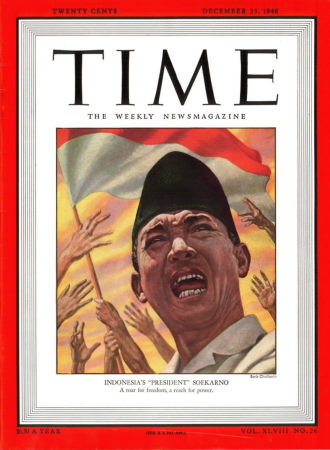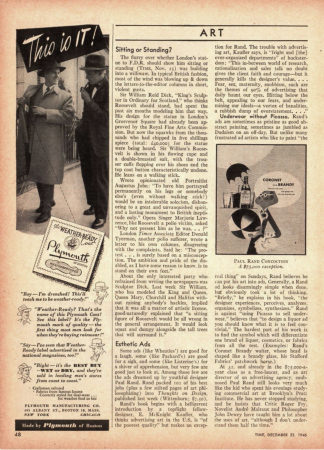The Original Text
By Unknown
Some ads (like Wheaties’) are good for a laugh, some (like Packard’s) are good for a sigh, and some (like Listerine’s) for a shiver of apprehension, but very few are good just to look at. Among those few are the ads dreamed up by youthful designer Paul Rand. Rand packed 102 of his best jobs (plus a few stilted pages of art philosophizing) into Thoughts on Design, published last week (Wittenborn; $7.50).
Rand’s book begins with a belligerent introduction by a topflight fellow-designer, E. McKnight Kauffer, who thinks advertising art in the U.S. is “of the poorest quality” but makes an excep tion for Rand. The trouble with advertising art, Kauffer says, is “fright and [the] over-organized departments” of huckster-dom: “This in-between world of research, rationalization and sales talk no doubt gives the client faith and courage—but it generally kills the designer’s value. . . . Fear, sex, maternity, snobbism, such are the themes of 90% of advertising that daily haunt our eyes. Hitting below the belt, appealing to our fears, and undermining our ideals—a vortex of banalities, a rubbish dump of overstatement. . . .”
Underwear without Picasso. Rand’s ads are sometimes as pristine as good abstract painting, sometimes as jumbled as Dadaism on an off-day. But unlike many frustrated ad artists who like to paint “the real thing” on Sundays, Rand believes he can put his art into ads. Generally, a Rand ad looks disarmingly simple when done, but obviously took a lot of thinking. “Briefly,” he explains in his book, “the designer experiences, perceives, analyzes, organizes, symbolizes, synthesizes.” Rand is against “using Picasso to sell underwear,” believes that “to design a liquor ad you should know what it is to feel convivial.” The hardest part of his work is to find the symbol which will differentiate one brand of liquor, cosmetics, or fabrics from all the rest. (Examples: Rand’s Coronet Brandy waiter, whose head is shaped like a brandy glass, his Stafford Fabrics’ patchwork horse.)
At 32, and already in the $75,000-a-year class as a freelancer, and as art director of an advertising agency, snub-nosed Paul Rand still looks very much like the kid who spent his evenings studying commercial art at Brooklyn’s Pratt Institute. He has never stopped studying, and he insists that Critic Roger Fry, Novelist André Malraux and Philosopher John Dewey have taught him a lot about the uses of art, “although I don’t understand them half the time.”




